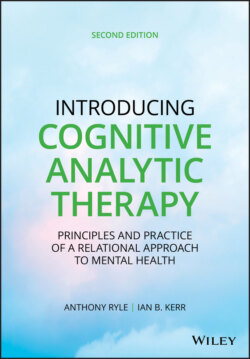Читать книгу Introducing Cognitive Analytic Therapy - Anthony Ryle - Страница 27
Background
ОглавлениеSeveral decades ago, there was hardly any evidence to show whether psychodynamic therapy worked, and cognitive therapy was still at a very early stage. To measure the effectiveness of therapy it is necessary to declare at the start what the aims are. This is a task easily accomplished by behaviorists where aims are defined as the relief of symptoms or modification of behaviors, but more difficult for psychodynamic therapists whose aims are complex and are often poorly articulated, or only emerge in the course of the therapy. One early pre‐CAT study was undertaken to address this problem (Ryle, 1979). This involved a careful reading of the notes of a series of completed therapies with the aim of finding out how early in therapy the key problems had been identified. This revealed that most therapies were concerned with only one or two key themes and that these had usually been evident early on, often in the first session. It also showed that much of the work of therapy had been directed to trying to understand why the patient had not revised the ways of thinking and acting which maintained these problems. On this basis, the “dynamic” aims of therapy could be defined early on as the revision of the identified, repetitive, or maladaptive patterns of thought and behavior.
Three patterns explaining this non‐revision were identified; these were labeled dilemmas, traps, and snags. These patterns would now be understood as varieties of reciprocal role procedures (RRPs)—see below. Dilemmas prevent revision because the possibilities for action or relationships are seen to be limited to polarized choices; the only apparent options are to follow the less objectionable choice or to alternate between them. Traps represent the maintenance of negative beliefs by the way they generate forms of behavior which lead to consequences (usually the responses of others) that appear to confirm the beliefs. In snags, appropriate goals are abandoned or sabotaged, because (or as if) it is believed that their achievement would be dangerous to self or others or otherwise disallowed.
Further studies combined ratings of these patterns with the use of repertory grid techniques (Brockman, Poynton, Ryle, & Watson, 1987; Ryle, 1979). (The basic principles of this technique are summarized in Appendix 4 for those interested.) At the start of therapy, patients completed such grids by rating how far a range of descriptions (constructs), partly elicited and partly supplied, were true of a range of elements consisting of significant people. In the case of the dyad grid (Ryle & Lunghi, 1970), the elements are the relationships between the self and significant people. Analysis of such grids provided a number of measures of the individual's way of construing self and other. Measures that reflected the issues which had been noted clinically and described in psychodynamic terms could be identified, and the changes in these seen to be desirable in terms of the aims of therapy could be specified. Repeating the grid after therapy showed how far such changes had occurred. Through the use of such repertory grids, described in Ryle (1975, 1979, 1980), it became possible to derive measures of change between pre‐ and post‐therapy testing that indicated how far dynamic aims had been achieved.
What started as an exercise designed to provide evidence of the effectiveness of dynamic therapy proved to be successful. Outcome research could now be based on identifying and measuring change in patients' “dynamic” problems, described as patterns of traps, dilemmas, and snags at the start of therapy, and on measuring change in the associated repertory grid measures. But the main effect was incidental to this aim, for this process, which involved explicit, joint work with the patient to identify and describe problems, had such a powerful positive effect on the course of therapy that conventional dynamic therapy was abandoned. The joint reformulation of the patient's problems became a key feature of what developed into CAT. Clear identification of and agreement between therapist and patient about aims, goals, and objectives is now well recognized as a common factor enabling and predicting successful therapy outcomes (Castonguay & Beutler, 2006; Castonguay, Boswell, Zack et al., 2010; Gabbard, Beck, & Holmes, 2005; Greenberg, 1991; Lambert, 2013; Norcross, 2011; Roth & Fonagy, 1996; Wampold & Imel, 2015).
